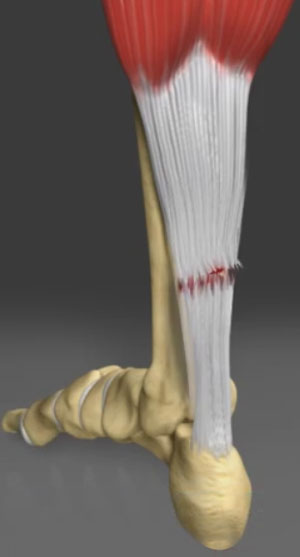Achilles Tendon Surgery

Achilles Tendon Anatomy
Tendons are the soft tissues connecting muscle to bone. The Achilles tendon is the longest tendon in the body and is present behind the ankle, joining the calf muscles with the heel bone. Contraction of the calf muscles tightens the Achilles tendon and pulls the heel, enabling the foot and toe movements necessary for walking, running and jumping.
Achilles Tendon Injury
The Achilles tendon is often injured during sports activities, resulting in an inflammatory condition called tendonitis, which is characterized by swelling and pain. In some cases, severe injury results in a tear or rupture of the Achilles tendon, requiring immediate medical attention.
Causes of Achilles Tendon Injury
The tear or rupture of the Achilles tendon is commonly seen in sports activities. The tendon ruptures as a result of weakness due to degeneration or from sudden bursts of activity during certain sports such as tennis, badminton, and basketball.
Symptoms of Achilles Tendon Injury
The classic symptom of an Achilles tendon rupture is the inability to rise up on your toes. You may often experience a “popping” or “snapping” sound with severe pain, swelling, and stiffness in the ankle region, followed by bruising of the area. If the tendon is partially torn and not ruptured, pain and swelling may be mild.
Diagnosis of Achilles Tendon Injury
The diagnosis of a torn or ruptured Achilles tendon starts with a physical examination of the affected area. Thompson test may be performed where the calf muscle is pressed with you lying on your stomach to check whether the tendon is still connected to the heel or not. In certain cases, an ultrasound or MRI scan may be ordered for a clear diagnosis.
Treatment of Achilles Tendon Injury
The main objective of treatment is to restore the normal physiology of the Achilles tendon so you can perform your normal activities.
Treatment of a torn or ruptured Achilles tendon includes non-surgical or surgical methods. Immediately following a torn or ruptured Achilles tendon you should employ the R.I.C.E. method as follows:
- Rest the injured leg.
- Ice packs should be applied at the site of injury to prevent swelling.
- Apply compression bandages to the injured area to prevent swelling.
- Elevate the injured foot to reduce swelling.
Other non-surgical methods involve casting the injured area for six weeks for the ruptured tendon to reattach itself and heal. After removal of the cast, physical therapy is recommended to prevent stiffness and restore lost muscle tone.
Indications for Achilles Tendon Repair
Surgery may be recommended especially for competitive athletes, those who perform physical work, or in instances where the tendon re-ruptures.
Surgery is contraindicated if you have unhealthy skin, an active infection, are diabetic, smoke and lead a sedentary lifestyle, and are unable to confer with the requirements of postoperative recovery.
Achilles tendon Surgery Repair Procedure: Mini-Open Surgery
Open repair of the torn tendon is common but newer biologic augmentation with a “mini-open” approach, can reduce traditional recovery times in half. During the surgery a min incision is made at the back of your leg. Your surgeon will stitch the torn tendon back together with strong sutures. Stem cells will be aspirated from your hip and injected into the Achilles as well, to improve the speed of recovery and improve the quality of the tendon.
We are at the forefront of developing novel techniques in treating these injuries, with biologic enhancement and rapid physiotherapy rehab to accelerate return to sport as quickly and safely as possible.
Benefits of Achilles Tendon Surgery
1. Tendon Repair: The main goal of Achilles tendon surgery is to repair a damaged or ruptured tendon. This will help restore the normal function of the Achilles tendon, which is vital for activities such as walking, running, and jumping.
2. Reduced Pain: In the cases where the Achilles tendon is causing pain and discomfort due to conditions like tendinopathy or partial tears, surgery can help alleviate this pain by addressing the underlying issue.
3. The Prevention of Recurrent Injuries: Achilles Surgery may reduce the risk of recurrent injuries, especially if the patient suffers from chronic Achilles tendon problems.
4. Improved Strength & Function: Achilles tendon Surgery can help restore the strength and function of the Achilles tendon. This will allow individuals to regain the normal movement and activities.
5. Faster Recovery: Recovery times can vary depending on the type and extent of the surgery. However, some individuals may experience a faster recovery with surgical intervention compared to conservative treatments alone.
6. Restoration of Normal Biomechanics: Achilles tendon surgery aims to restore the normal biomechanics of the ankle and foot. This is essential for proper gait and movement.
7. Correction of Structural Abnormalities: Surgery can address structural abnormalities in the Achilles tendon, such as elongation or shortening, helping to optimize the biomechanics of the foot and ankle.

















